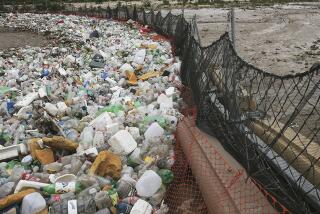Sewage a Sensitive Issue as Foreign Ships Arrive
- Share via
SAN DIEGO — It’s ticklish, this matter of Navy sewage.
When an aircraft carrier berths in San Diego Bay, what happens to the waste from its population of 5,000 generating an estimated 30 to 40 gallons of waste water daily per crew member?
Under some duress from Congress, the U.S. Navy has spent the better part of a decade retooling to keep sewage out of places like San Diego Bay. Now ships shut off sewage discharge a few miles out and use holding tanks until they hook into pipes that connect with municipal sewers.
But this week, San Diego welcomes an unusually large contingent of foreign ships--eight Japanese, three British and one Indonesian. The Japanese arrived Saturday and the British arrive today for a much ballyhooed 10-day port visit and exercises in the Pacific.
So?
As early as February, the Britons’ plans had been hammered out, according to an 8-page British Navy “ship visit planning sheet.”
There was discussion of telephones, mail, cocktail parties, press conferences, sporting events and visits to San Diego homes.
The explanation under the heading “sewage disposal” was terse and cryptic:
“Port Authority would prefer not to know!”
As late as last week, officials at the Port of San Diego said they were still unclear about precise arrangements for the visit.
But they were adamant that no sewage would land in the bay.
“Absolutely not,” said William Garrett, manager of marine operations.
William Donlan, chief wharfinger for the port, concurred: “No problem, it’s been taken care of.” Asked how, he would say only, “We are taking care of it, and I’m not going to go into any big technical flap on how to do it. . . . That’s above and beyond the call of duty.”
Talk to the Navy, he suggested.
At first, the Navy had no details. Yet they had all sorts of information about the British--lists of commanders, arrangements for group tours, and “press availabilities.”
“We have all kinds of things planned,” Lt. Nancy Decker said of the British visit. “They’ll be doing a lot of social activities--parties, receptions, soccer matches, Padre games.”
“We want their sailors to be treated nice,” she said.
Asked about sewage, Decker said simply, “They have their own containers. They process it. . . . As far as I know, nothing is going into the bay.” For further details, she referred questions to Master Chief Billy Kinder.
Kinder said foreign ships are required to abide by the rules of the port, which in San Diego prohibit dumping into the bay. He said the visiting ships would have holding tanks.
For 10 days?
“I hope so,” he said.
In Los Angeles, Angus Mackay, public affairs officer for the British Consulate General, did some checking and came back with the word that the British are “very much aware of and sensitive to this problem.” The ships will either have “treatment plants,” he said, or will “request temporary shore facilities” such as portable toilets.
But U.S. Navy Lt. John Hopkins, another Navy spokesman, said he had heard nothing about portable toilets. Instead, he said early last week that sewage removal services would be provided by contract with a civilian company.
Asked for the name of the company, Hopkins demanded, “Why do you have this obsession with sewage?”
At mid-week, Hopkins called back to say the contract had not yet been awarded. It would be within a day or two, he said. Two days later, Hopkins said the contract would go to Cleaning Dynamics, a San Diego-based maritime cleaning contractor.
Cleaning Dynamics general manger Richard Martin said the plan was that Cleaning Dynamics would assist the British at their request if they needed help.
But the U.S. Navy was weary of the sewage question.
Said Capt. Peter Litrenta, a U.S. Navy spokesman: “It’s up to those ships what they’re going to do about it. They’re not U.S. Navy ships.”
More to Read
Sign up for Essential California
The most important California stories and recommendations in your inbox every morning.
You may occasionally receive promotional content from the Los Angeles Times.













